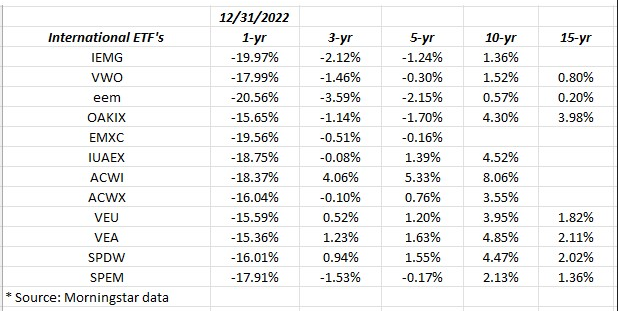2022 was the first year since 2016 that value investing thoroughly trounced growth investing.

Click on the above table and you can see the progression between growth and value amongst the large-cap, mid-cap and small-cap asset classes.
It should be no surprise to readers: growth had a nice spurt off the lows in June and October ’22 but the higher 10-year Treasury yield is acting like a wet blanket for growth stocks.
Don’t ignore the annual return or “annualized” data found in the bottom left-hand corner of the spreadsheet. Longer-term large-cap growth returns still look too high, although the 3-year return is now more normal so to speak. The mega-cap and large-cap names
Non-U.S. Ripe for a Continued Drop in the Dollar:
Looking at annual return data, there is no question that non-US and International look ripe for some robust returns, particularly looking at the 10-year and 15-year annual returns.

But what’s the catalyst? Maybe a weaker dollar.
The last time non-US did really well for an extended period was the decade from 2000 to 2009 when large-cap growth imploded with March 2000, peak.
Maybe the negative returns this year in the Non-US asset class (the tickers listed above are non-US and international ETFs including international mutual funds) can’t be faulted given Ukraine and China’s issues, but China is supposedly set to begin re-opening and Ukraine may be a non-issue moving forward if it remains in stalemate.
This isn’t a prediction but I continue to think that non-US investing opportunities, meaning international and emerging markets, have a compelling risk/reward when looking at the 10 and 15-year annual returns.
This blog is just waiting for a stronger signal to allocate more funds to Non-Us investments, like the (Oakmark International Fund Investor Class) or the iShares MSCI Emerging Markets ex China (NASDAQ:EMXC).
Disclosure: This is a bigger-picture analysis. These shifts take time to develop so take it all with a dose of skepticism.
Which stock should you buy in your very next trade?
AI computing powers are changing the stock market. Investing.com's ProPicks AI includes 6 winning stock portfolios chosen by our advanced AI. In 2024 alone, ProPicks AI identified 2 stocks that surged over 150%, 4 additional stocks that leaped over 30%, and 3 more that climbed over 25%. Which stock will be the next to soar?
Unlock ProPicks AI
